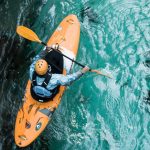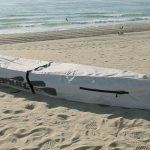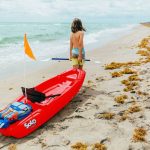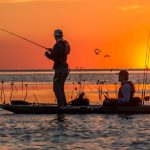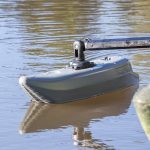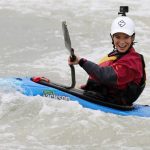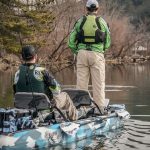In this article, we’ve reviewed our top picks for beginner whitewater kayaks. You’ll also find a comprehensive guide to help you decide which one is best for you.
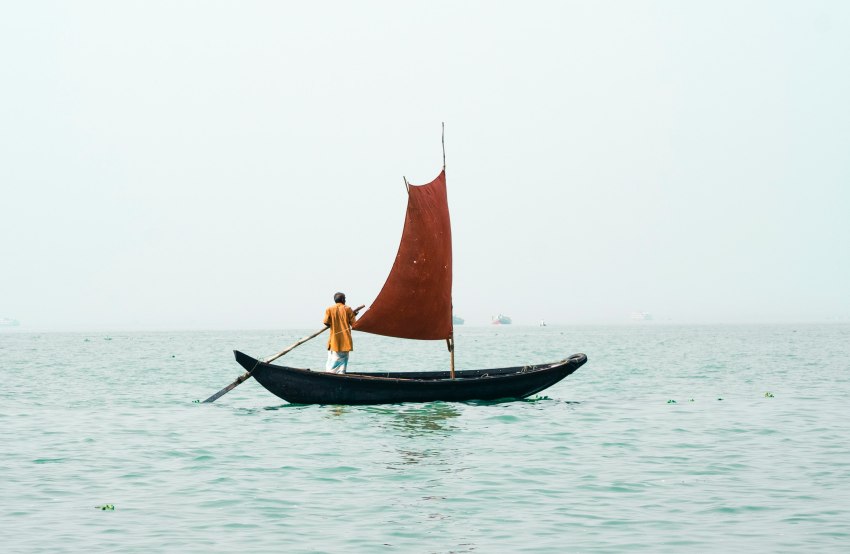
Let’s be honest: when kayaking, the wind is a real pain in the butt more often than not!
Yes, on the uber-hot days, there’s nothing more delightful than a cool breeze to help cut the heat.
The rest of the time, though, the wind just lowers the temperature, splashes spray in your face, turns the water choppy, and makes it that much harder to paddle.
But there’s one simple thing you can do to turn the wind from an annoyance into a tool for greater enjoyment: mount a sail on your kayak.
Kayak sails do what sails have done for boats since the beginning of boating—they harness the power of the wind to propel you forward (sometimes faster than you can paddle!).
Below, we’ve compiled a list of the absolute best kayak sails on the market, with options of all shapes, sizes, functionalities, and price ranges.
Check out the list, then make sure to read the buying guide and FAQs sections, too, so you can learn everything you need to know about these handy additions to your paddling trips!
As an affiliate of Amazon and other retailers, we may earn a small commission when you buy via our links, at no additional cost to you. Thank you!
Quick Answer: The Best Kayak Sails
- Best Overall: Hobie Mirage Sail Kit
- Best Budget: LoneRobe 42 inches Downwind Wind Sail
- Most Durable: Sea Eagle QuikSail Universal Kayak Sail
- Fastest-Deploying: ADVANCED ELEMENTS Rapid Up Kayak Sail Kit
- Best Foldable Kayak Sail: Dyna-Living 42” Foldable Downwind Kayak Sail
- Best Full-Size Kayak Sail: Any-Kayak Upwind Sail Kit
- Best Customizable Kayak Sail: FalconSails Custom Sails
- Best Premium: BSD Batwing Sail Kit 32 Inch
Comparison table: The Best Kayak Sails
| Model | Specs | Where To Buy |
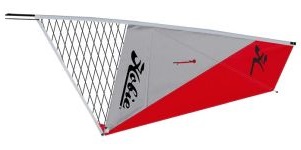 Hobie Mirage Sail Kit | Weight: 12.5 lbs Dimensions: 20.25 sq ft Material: Unspecified | Amazon |
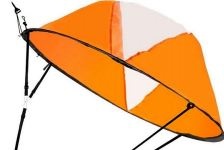 LoneRobe 42 inches Downwind Wind Sail | Weight: 0.85 lbs. Dimensions: 0.29 sq ft Material: PVC, polyester | Amazon |
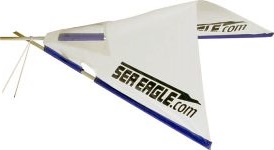 Sea Eagle QuikSail Universal Kayak Sail | Weight: 4.2 lbs. Dimensions: 14 sq ft Material: Aluminum frame, PVC and tetron polyester sail | Amazon |
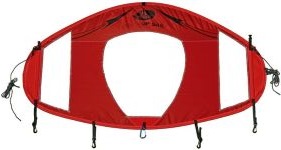 ADVANCED ELEMENTS Rapid Up Kayak Sail Kit | Weight: 2 lbs. Dimensions: Unspecified (roughly 40-45 inches wide) Material: Ripstop synthetic fabric | Amazon |
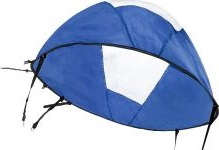 Dyna-Living 42” Foldable Downwind Kayak Sail | Weight: 1 lbs. Dimensions: 0.29 sq ft Material: Polyester taffeta, composite material batten | Amazon |
 Any-Kayak Upwind Sail Kit | Weight: 35 lbs. Dimensions: 45 sq ft Material: Dacron sail, polycarbonate frame | Sailboats To Go |
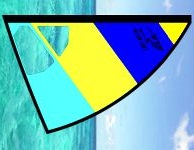 FalconSails Custom Sails | Weight: 3.8 ounces for the sail alone, under 4 lbs. for the rigging kit Dimensions: 10/76 sq ft Material: Dacron polyester, carbon fiber frame | Falconsails |
 BSD Batwing Sail Kit 32 Inch | Weight: 36 lbs. Dimensions: 32 inches wide, adaptable between 20 and 26 sq ft Material: Dacron polyester cloth, aluminum mast and boom | Kayakshops |
Best Kayak Sails
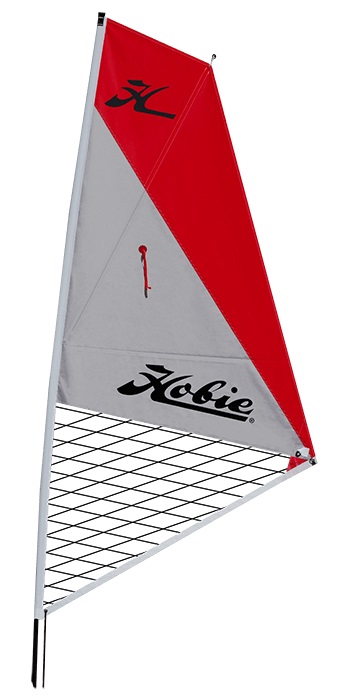
Best Overall: Hobie Mirage Sail Kit
Weight: 12.5 lbs (5.7 kg)
Dimensions: 20.25 sq ft (1.88 sq m)
Material: Unspecified
This L-shaped sail is just what you need if you’re an experienced sailor/paddler looking to step up your game with a sail. The two-piece mast is easily assembled and mounted, and the boomless sail and diagonal batten design ensure easier handling when the wind is high. Though it’s specifically built for the Hobie kayak line, the mounting system may be compatible with (or adaptable to) other models.
The kit includes all the lines and fittings needed, as well as a storage back to keep it tucked safely away when not in use. It’s designed to roll up so you can fit it by your side in a sit-on-top kayak. When paired with Hobie’s MirageDrive pedal system, it offers superior steering and handling. Thanks to its durable components, it’s one of the longest-lasting sail systems on the market.
The only real downside is that its smaller-than-average size won’t fill with lesser winds. You’ll really only pick up speed with winds above 10 knots.
Pros:
- Easy to deploy/unfurl
- Mounting hardware compatible with Hobie kayaks
- Makes for highly practical and efficient steering/handling
- Sturdy and long-lasting
- Large design capable of handling high wind speeds
Cons:
- Doesn’t catch lesser/slower winds effectively
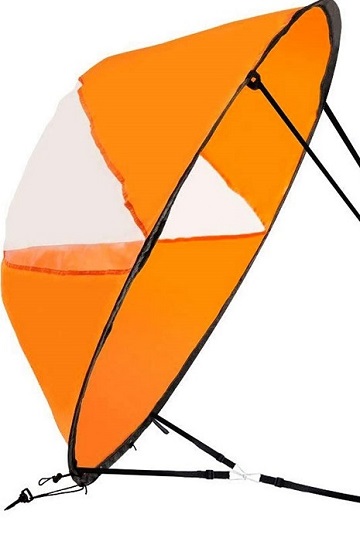
Best Budget: LoneRobe 42 inches Downwind Wind Sail
Weight: 0.85 lbs. (0.4 kg)
Dimensions: 0.29 sq ft (0.03 sq m)
Material: PVC, polyester
If you’re all about keeping it cheap, give this circle-shaped sail a closer look. It’s definitely one of the most beginner-friendly sails on our list, designed to deploy with minimum effort. Sure, it’ll really only pull you in one direction (downwind), but you’ll find that it can pick up even lesser winds and help you build up impressive speed on those blustery days.
The sail is made from eco-friendly PVC and polyester. It’s surprisingly sturdy and resistant to rips and tears. The clear window makes for excellent visibility so you can always see where you’re going. Thanks to its clip-on design, it can be used on paddleboards, kayaks, canoes, and any light watercraft with D-rings or mounting hardware.
On the downside, though, it’s a bit tricky to set up when you’re out in the middle of a lake, so make sure to have it all clipped in place and ready to deploy before you head out.
Pros:
- Lightweight but sturdy
- Very inexpensive
- Easy to deploy when the wind picks up
- Simple, newbie-friendly operation
Cons:
- No real steering/handling capabilities
- Plastic may melt in prolonged sunlight and heat
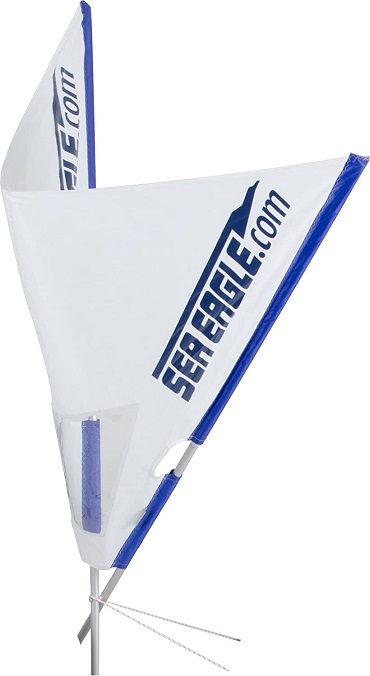
Most Durable: Sea Eagle QuikSail Universal Kayak Sail
Weight: 4.2 lbs. (1.9 kg)
Dimensions: 14 sq ft (1.3 sq m)
Material: Aluminum frame, PVC and tetron polyester sail
The Sea Eagle QuikSail is a V-shaped sail that is built specifically for kayakers to take out on the open ocean or a vast lake, built with an aluminum frame that can withstand a LOT of pressure/strain in even heavy winds. The sail is also made by Neil Pryde, using a sturdy blend of PVC and tetron polyester that will last for years of hard use.
It’s designed for hands-free operation, and though it’s not the most versatile sail on our list, it will still help you pick up serious speed as long as you’re paddling downwind. It can be broken down into individual components (the longest is 43 inches long) and stored in your compartment or beside your seat, but it’s easy to assemble and unfurl when it’s time to zoom across the windy lake.
Fair warning: it’s designed specifically for Sea Eagle kayaks, so it may not be compatible with other brands/mounting hardware. Also, the tie-downs and hooks provided with the sail don’t function effectively—they’re flimsy and ineffective, so may need replacing.
Pros:
- Easily folded/stowed and unfolded/deployed while out on the water
- Hands-free function; keep paddling and let the wind do the work
- Sturdy, built to last
- Not too pricey
Cons:
- Hardware (tie-downs and hooks) are flimsy and should be replaced before using
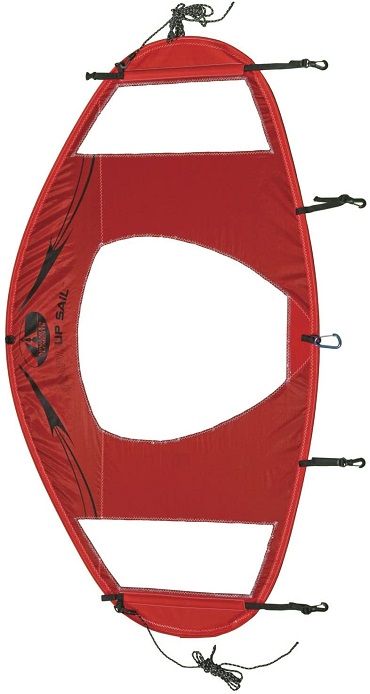
Fastest-Deploying: ADVANCED ELEMENTS Rapid Up Kayak Sail Kit
Weight: 2 lbs. (0.9 kg)
Dimensions: Unspecified (roughly 40-45 inches wide) (0.03 sq m)
Material: Ripstop synthetic fabric
If you’re looking for a kayak sail that will get you up and running in seconds, this Advanced Elements kit is the perfect choice. It folds down into an 18-inch disc that you can easily store, but when it’s time to deploy, just unfold it and let the wind fill it up. The “Rapid Up” design incorporates plastic battens in the sail’s perimeter that enables it to catch the wind immediately, and you’re off to the races!
The sail is made of durable ripstop synthetic fabric (though which synthetic fabric, polyester or nylon, it doesn’t specify) and comes with adjustable attachments that are compatible with just about any kayak on the market. Thanks to the central window and the two side windows, you’ve got a nearly obstructed view of your surroundings while still enjoying a large sail.
However, in light-to-medium winds, this sail is largely ineffective. You’ll have to wait for those very windy days to really put it to the test.
Pros:
- Sturdy, well-built, and can handle the tension of high winds
- Great visibility
- Easy to fold down small and stow in any storage compartment/behind your seat
- Compatible with all kayak models
Cons:
- Only effective in heavy winds

Best Foldable Kayak Sail: Dyna-Living 42” Foldable Downwind Kayak Sail
Weight: 1 lbs. (0,45 kg)
Dimensions: 0.29 sq ft (0.03 sq m)
Material: Polyester taffeta, composite material batten
Give this folding-down kayak sail a try, and you’ll be glad you did! It’s made using ultra-tough and eco-friendly polyester taffeta, with triple-stitched and reinforced seams. The perimeter batten is also made from composite materials that claim to be “unbreakable”, but which have proven to be (at the very least) incredibly durable.
The folding design allows you to fold it down into a flat circle just 15.3 inches wide.It fits into the accompanying pouch and can be stowed in your storage compartments to keep it out of the way. However, it deploys in literally two seconds, and it’s easy to clip it onto your paddleboard’s D-rings or the kayak mounting hardware.
Be warned, though: there are no lines included, so you’ll have to provide your own to connect it to your kayak. And definitely make sure you’re not fumbling with it in high winds out on the water, or you run the risk of capsizing/tipping.
Pros:
- Easy to set up and deploy in seconds
- The most compact kayak sail on our list
- Lightweight but sturdy
Cons:
- No lines/ropes/cords provided to secure the sail to your kayak
Best Full-Size Kayak Sail: Any-Kayak Upwind Sail Kit
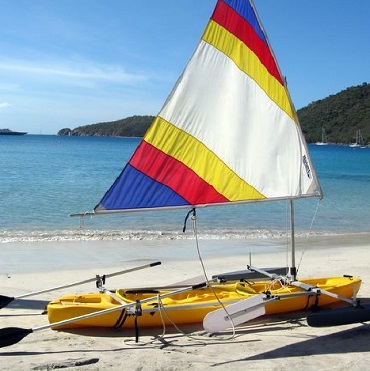
Weight: 35 lbs. (15.9 kg)
Dimensions: 45 sq ft (4.2 sq m)
Material: Dacron sail, polycarbonate frame
Take note: this kayak sail is perfect for high-speed paddling, but you’ll need a VERY stable kayak with a higher-than-average weight capacity in order to handle it. It’s likely best on a fishing kayak, and suitable only for paddlers with a lot of experience.
This L-shaped sail is built with a three-piece mast-and-boom design and a 45-square foot sail that can catch even light winds and push you along at impressive speeds. It rolls up and folds down to roughly 4 feet long, so you’ll need to have a special mount/hardware installed on the kayak to store it when not in use. But as long as it’s deployed, you’re all but guaranteed to catch plenty of wind.
One very cool thing: the sail kit can be purchased together with inflatable stabilizers, which increase the stability of your kayak by mounting two outrigger-style arms to either side of your vessel. It even comes with its own built-in steering oars that make it easy to keep the kayak on track when the wind is blowing.
Pros:
- Turn your kayak into a next-level sailboat
- Designed for the experienced sailor
- Ultra-sturdy
- Great for high-speed paddling
Cons:
- Heavy and expensive
- Requires significant expertise to handle
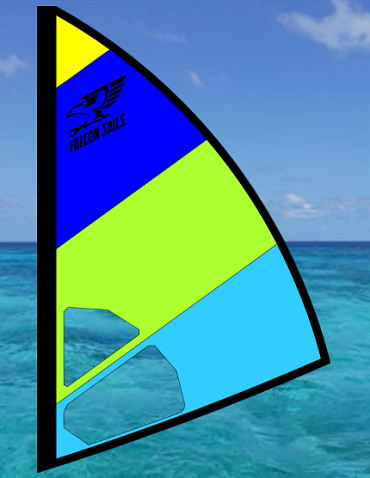
Best Customizable Kayak Sail: FalconSails Custom Sails
Weight: 3.8 ounces for the sail alone, under 4 lbs. for the rigging kit (1.81 kg)
Dimensions: 10/76 sq ft (1 sq m)
Material: Dacron polyester, carbon fiber frame
Want to create the perfect sail for your kayak according to your preferences? Then you’ll love Falcon Sails! The sail is fully customizable, allowing you to choose from 12 colors for each of the four panels, the insignia, and the trim. You can also choose to buy just the sail (with no extra hardware) or the complete rigging kit (for a higher price).
The sails are made using Dacron cloth (ultra-tough polyester), and the entire kit weighs less than 4 pounds. The mast is made from durable carbon fiber and is capable of withstanding a lot of tension and strain, even in high winds.
Of course, given the fact that it’s custom work, you’ll also pay a premium price. You can expect to spend more on this kayak sail than almost any other on our list. But if you want a sail built your way, it’s a great option for you.
Pros:
- Build the perfect sail for your kayak and taste preferences
- Sturdy and reliable
- Well-designed, beautifully functional
- Break-down mast and boom that can be easily stored inside your kayak
Cons:
- Pricey
- Long wait time for shipping/delivery
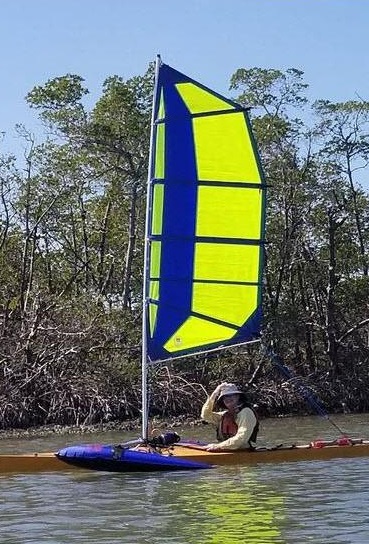
Best Premium: BSD Batwing Sail Kit 32 Inch
Weight: 36 lbs. (16.3 kg)
Dimensions: 32 inches wide, adaptable between 20 and 26 sq ft (2.42 sq m)
Material: Dacron polyester cloth, aluminum mast and boom
This is a kayak sail built unlike the rest on our list! It doesn’t adhere to the standard shapes (V, L, or circle), but is shaped like a batwing, built in the style of hang gliders. Standing 11 feet tall, it’s capable of handling fast, heavy winds and bringing you up to some serious speeds. Sure, it’s heavy and a bit ungainly to wrestle with, and you’ll need a very stable kayak to keep it from tipping over. But for anyone who wants to take their speed to the next level, it’s an amazing choice.
For the premium price (the highest on our list), you get a 32-inch-wide expedition sail that can expand up to 26 square feet of surface area, a tough-as-nails aluminum mast with an attached boom for easy handling, and two outriggers to maximize stability. It even comes with a fit kit that lets you adapt your kayak to the mounting hardware provided. If you have any trouble, you can easily contact the helpline and you’ll have 24/7 phone support with an expert.
Pros:
- Ultra-versatile, excellent steering
- Premium quality, durability, and reliability
- Around-the-clock phone support for installation and troubleshooting
- Can be adapted to fit (nearly) any kayak
- The “Cadillac” of kayak sails
Cons:
- Very expensive
- Not easy to set up or use—suitable only for experienced sailors
Why Should I Add a Sail to a Kayak?
Before we dive into the buying guide, we’ve got to take a look at what makes using a kayak sail such a great idea. There are a lot of amazing “pros” to using kayak sails, including:
- Go faster. How fast can you really paddle? When you get up to full steam, you’re probably hitting around 2 MPH—or 1.7 knots. If you really push the pace, you may be able to hit 2 knots, but how long can you sustain that pace? Eventually, your arms are going to get tired, you’ll run out of energy, and you’ll slow down to the usual paddling speed. But with the wind driving your kayak, you can go much faster than if you’re paddling. Essentially, the more powerful the winds, the faster you can go. You’ll be slicing through the water and making serious progress—it’s the perfect option for touring and expedition kayaks with long distances to travel!
- Work less. Remember the whole “arms getting tired after hard paddling” thing? Even if you’re just paddling at regular speed, you’re eventually going to run out of steam. Long hours of muscle contractions/relaxation, perspiration, heat, and sunlight combine to tire you out, until you just can’t paddle anymore. With a sail, that’s not really an issue. Any time the wind picks up and blows in the right direction, you can let the sail do the work of propelling you forward—no exertion or strain necessary.
- Relax more. While the sail is doing all the hard work, you can sit back and relax. Put up your feet, take a water break, and enjoy the speed. You get more relaxation on the water because there will be plenty of time when you don’t have to paddle, so you can focus on enjoying the view, having a drink of water, or even eating a snack.
- Move quieter. Paddles make far less noise than trolling motors, but they can still be too noisy if you’re trying to sneak up on fish. The tiny splashing that’s made every time you dip your paddle into the water might drive away that big fat bass or trophy trout. With a sail, though, you’re running in absolute silence. No paddling or pedaling, no vibrations of a running motor. Just smooth, silent gliding. It even makes for easier trolling, and you’ve got both hands free to grip the fishing pole as you trail the baited hook behind you.
All pretty great reasons to mount a sail on your kayak, right?
Disadvantages of Using a Kayak Sail
In the name of transparency, I’ve got to be honest and say there are some “cons”, too. While using a sail has the potential to make your paddling, angling, or kayak hunting trip more enjoyable, it can also come with some downsides, including:
- Less stability. The sail can actually increase the risk of tipping over, especially in high winds and choppy surf.
- Very hard to roll. If the wind tips you over, the attached sail is going to make it virtually impossible to roll the kayak back over. You’ll have to detach the sail, right the kayak, then secure the sail and re-mount. Not at all easy for self-rescue out in the middle of a lake or the ocean.
- Distracting. You have to pay attention to the sail—maneuvering it just the right way so it catches the wind and handling it to keep your kayak on course—which can distract you from navigation, talking with your fellow paddlers, or enjoying the view.
Granted, these are minor cons, but you need to be aware of them before you take that sail out on your next kayaking adventure.
Choosing the Best Kayak Sails: Factors to Consider
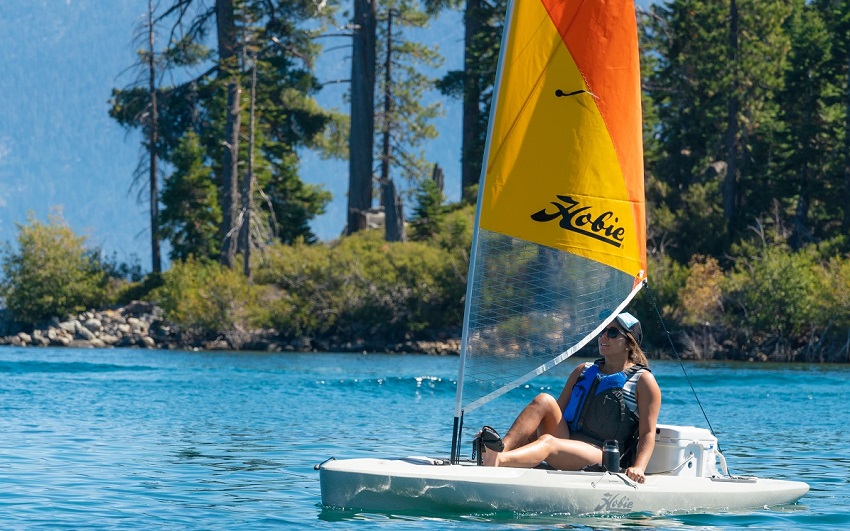
If you’re as excited to use a kayak sail paddling as I am, no doubt you’re already eager and raring to hit the lake or ocean so you can test it out. But first, you’ve got to find the right sail to mount on your kayak.
To do that, you’ve got to consider a few critical factors.
Types of Sails
There are three basic types of kayak sails:
V-Shaped Sails
These sails are, as their name suggests, shaped like a V, with the majority of the wind-catching portion near the top of the sail. Their higher height makes them highly effective at catching the wind, and they’re best for sailing downwind. The design also makes them less likely to impede your view as you paddle/sail, so they make it easier to navigate/stay on course.
They’re a beginner-friendly choice, but experienced paddlers/sailors will still find them highly reliable and useful for overseas/long-distance travel.
However, there are a few drawbacks to this type of sail:
- The smaller surface area means less wind-catching abilities, so they’re not the fastest of the kayak sails.
- They don’t easily change direction, but tend to stay fairly fixed in one direction (downwind).
- They are top-heavy, which means in high winds, your risk of capsizing is significantly higher.
Circle-Shaped Sails
These sails are circle-shaped, more like a parachute or parasail than your traditional boat sails. They’re perfectly suited for beginners because there’s virtually no learning curve to using them. When the wind picks up, just throw the sail into the air to catch the wind, and you’re off to the races! Easy peasy, no hassle or fuss.
Most of them are fairly simple to control, and they typically come with a built-in clear window so you can still navigate while the sail is full. They’re the ideal solution for learning basic sail-handling skills. The fact that they’re hand-controlled and anchored to the bow of your kayak makes them a very low-maintenance solution. They’re also not going to interfere with your stability or increase your risk of capsizing.
On the downside, though:
- They really only travel downwind. There’s not a lot of versatility or maneuverability with these sails.
- Many of the “budget” models are poorly designed and prone to breakage.
L-Shaped Sails
These sails are shaped like an L, much like the sails you find on a yacht or sailboat. Their traditional style makes them ideal for experienced sailors who know how to handle a maneuverable sail. They feature both a mast (vertical pole) and boom (horizontal pole) that lets you catch the wind no matter which way it’s blowing, so you can sail in every direction, not just downwind.
However, the drawbacks of this design include:
- More complexity. If you’re not an experienced sailor, you’ll likely spend more time wrestling with the sail than making any real progress. I
- They’re heavier, more top-heavy, and more likely to cause you to capsize. Once you’ve tipped over, you’re going to have to detach the sail in order to right and remount your kayak.
- Not all kayaks are compatible with this type of sail. Even if your kayak is compatible, you may have to buy a specific mount to install an L-shaped sail.
Sail Materials
Kayak sails are typically made from a few select materials:
Plastic
Plastic is the perfect material for sails: cheap, waterproof, and lightweight. It’s not the sturdiest of the sailcloths/fabrics, and it’s prone to deteriorating upon frequent exposure to saltwater. You’ll have to wash the plastic regularly in order to keep it in good condition. You may also have to replace plastic sails more frequently (every 1-2 years) because of how quickly they wear out or break. Thankfully, they’re very budget-friendly (as you’ll see by the options below).
Synthetic Fabrics
A number of synthetic fabrics are used to make higher-end sailcloths.
- Ripstop polyester is a mid-range material that has a bit of elasticity, so it’s typically used for V-shaped and L-shaped sails. It costs more than plastic but is still a fairly affordable synthetic fabric.
- Ripstop nylon is generally tougher than polyester, though it lacks polyester’s flexibility/elasticity. It’s also more water-resistant (especially when treated with a polyurethane coating) and able to withstand more damage from salt.
- Dacron is a premium woven polyester specifically designed to be used for sails/around water, and it’s tough enough on its own to not need resin/polyurethane coatings. However, it’s also a very pricey option, so it’s really only used on premium sails.
- Mylar is a clear, plastic-like polyester film typically used for the “viewing windows” in circular sails. It’s transparent like plastic, though not quite as tough as dacron, polyester, or nylon.
Laminated Cloth
Some old-school-style kayak sails use laminated sailcloth, which is made from multiple layers of waxed or coated cloth combined for strength and impermeability. Laminated cloth tends to be heavier and more cumbersome than the synthetic fabrics or plastic, but has higher tensile strength and greater durability.
Aluminum or Carbon Fiber
This is typically used for L-shaped sails, which require a mast and boom that is both sturdy and lightweight. V-shaped sails may also use aluminum or carbon fiber for the poles that form the frame to support the fabric.
Weight: How heavy is a kayak sail?
Weight is always a factor to consider when kayaking!
The heavier your kayak, A) the harder it becomes to paddle, and B) the higher your risk of capsizing.
Typically, you should pack no more than 70% of the kayak’s weight capacity—that includes you, your PFD, paddle, and all your gear.
However, if you add on a sail—especially an L-shaped sail with a boom and mast—that’s a lot of extra weight. Perhaps even too much, depending on what else you’re hauling around.
Fishing kayaks with a very high load capacity can handle a sail. On the other hand, light, compact kayaks designed for speed tend to have a lower load capacity, so the sail may be a bit too much weight.
And remember, the materials used in the sail will also affect the weight. A plastic circular sail will be incredibly lightweight, while a V-shaped sail will be heavier and an L-shaped sail the heaviest.
Choose a sail that you know your kayak can accommodate along with you and the rest of your gear.
(Note: We made sure to include the weight of each kayak sail on our list to help you know at a glance if your kayak can handle it.)
Packed Size
Just like weight, the size of things is always a factor you need to carefully consider when planning your paddling trips.
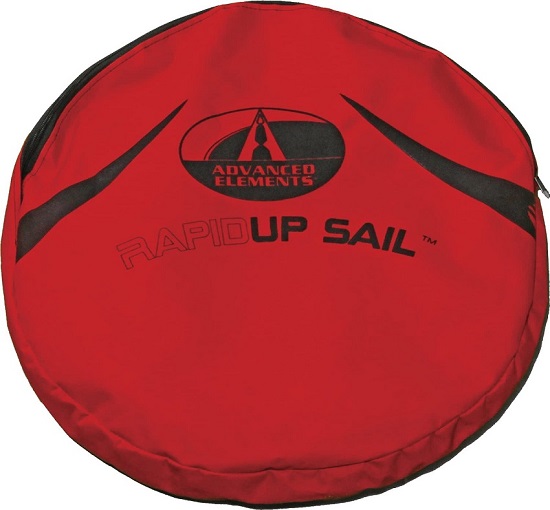
Anything that’s too long, wide, or bulky will just get in your way. Unless you’ve got a ton of mounts and open compartments (like some fishing kayaks have), a bulky, oversized sail is just going to be a pain in the butt and make it impossible to paddle.
Thankfully, most kayak sails are designed to fold down fairly small.
Circular sails are the smallest—they basically collapse into a circle-shaped pile of fabric you can drape over your bow or tuck away easily into any storage compartment.
V-shaped sails are a bit larger, with long poles that support the fabric sail. You may be able to store them in a paddle keeper or paddle mount, or in a sit-on-top kayak, you may be able to fit them in the open cockpit next to your seat.
L-shaped sails are the largest and most cumbersome. Not all of them will fold down small, so you’ll need more storage space. Sit-on-top kayaks may have space in the open cockpit, but for a sit-in kayak, you will definitely need a special storage solution (brackets, mounts, etc.) to keep the sail out of your way as you paddle.
Remember: you’re not always going to paddle with the sail up. Sometimes the wind will be too strong and using a sail will cause you to capsize. Or maybe you’re paddling against the wind (to return to your launch point) and the sail will work against you.
You always need to know for sure you can collapse and store the sail safely out of your way when you’re on the water.
Experience Level
Let’s be honest: most of us kayakers have plenty of experience paddling, but not a whole lot handling a sail. In fact, some of us likely took up kayaking because it was an easier (and cheaper) alternative to boating.
Now, if you’re one of the lucky people who has spent a lot of time on a sailboat, you’ve probably got sail-handling skills for days. If so, you’ve got all the options in the world as to which type of sail to use.
For the rest of us, experience (or, really, the lack thereof) is a major factor to consider.
Circular sails are the easiest to handle and require the fewest skills, so they’re a great place to get started.
If you’re confident you can handle a sail, you can always upgrade to a V-shaped sail and get a bit more advanced.
But only go for an L-shaped sail if you know you’ve got the chops to handle it. Otherwise, you’re going to spend the majority of your time out on the water wrestling with a stubborn, capricious, or unmanageable sail.
Price
Yes, price is a factor to consider, for a number of reasons!
First, you want to get out on the water without spending a small fortune on gear. You’ve probably dropped a pretty penny on a top-quality kayak, a great paddle, solid PFD, and so on. Paying another small fortune just to add a sail may be a hard (expensive) pill to swallow. BTW, you might want to familiarize yourselves with our Guide to Kayak Prices.
Circular sails tend to be the cheapest and the easiest to install—no mount needed. Just secure it to the bow and get out on the water.
V-shaped sails are a bit pricier and may require the purchase of a mount (if one isn’t included with the sail).
L-shaped sails are the most expensive and will definitely require some specialized hardware.
Kayak Sailing Tips
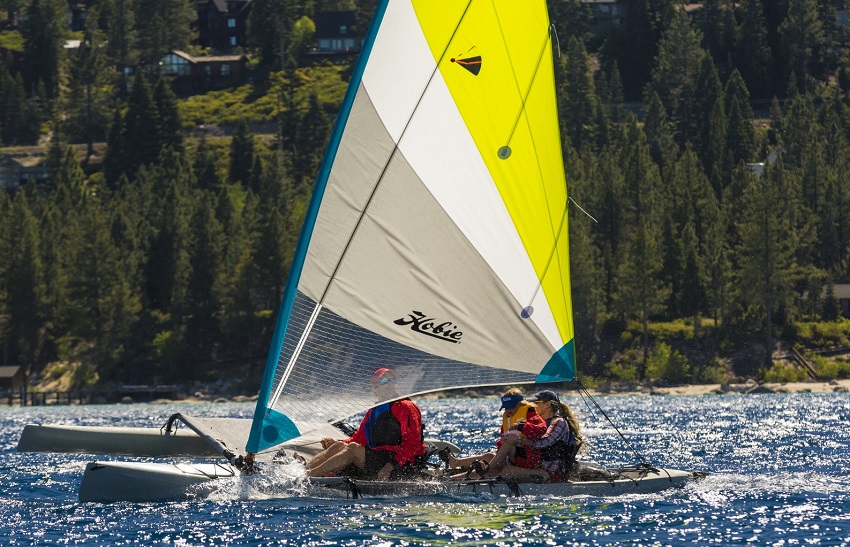
If you’re planning on taking your kayak out on the water with a sail installed, here are a few tips to help you paddle safely and effectively:
Make sure to use a stable kayak. The force of the wind pushing against the sail will tip the kayak to one side, increasing the risk of tipping over. It’s best to use a kayak has high secondary stability for kayak sailing.
A keel can be game-changing. Keels help to increase stability and prevent capsizing. If you don’t have one installed, it may be a good idea to mount one when planning to go kayak sailing.
Use a rudder. The combination of rudder and sail will help you to steer more effectively at top speed when propelled by the wind. You can always use your paddle to steer, but if your hands are full with the sail, it’s better to have a foot-controlled rudder for managing your course.
Make certain the sail mount is reinforced. There is going to be a lot of force pushing on the spot where the sail is mounted to your kayak. If the kayak comes with a built-in mount, it will likely already be reinforced. But if you’re DIYing it, make certain to add extra reinforcement to the mounting point.
Pre-assemble the sail on dry land. The last thing you want is to be fumbling around with sail components (mast, booms, guy lines, sailcloth, etc.) when you’re out on the water. Assemble everything on dry land, and have it ready for quick-and-easy mounting before you paddle out.
Start paddling with the sail furled (rolled up). Only unfurl the sail once you’re well away from land and facing the correct direction (downwind).
Practice angling your kayak and sail to pick up the wind. Circular sails make for “parachutes” that propel you straight forward, but L-shaped sails give you more flexibility and versatility. Don’t sail directly downwind, but angle your kayak to one side and the sail to the other side to pick up the wind.
For more awesome kayak sailing tips, you can watch this video by the ever-epic Ryan Wood:
Safety Tips:
Planning on taking your kayak sailing? Make sure to follow these safety tips:
Install the sail correctly. Make sure to thoroughly read the instructions and ensure the sail is correctly mounted. Otherwise, it could blow away, injure you, or even damage your kayak!
Always wear PFD. Because of the higher risk of capsizing, you’ll definitely want to wear your PFD when out on the water with the sail. It may be the only thing to keep you afloat if you tip over.
Be wary of strong winds and waves. While you do want some wind when sailing, there is such a thing as TOO MUCH wind. Strong winds typically mean choppier water, which means a higher risk of A) capsizing, and B) your sail being blown/ripped off your kayak. Strong winds can also blow you off course and send you in the wrong direction. Always check the weather/wind forecasts before heading out paddling.
Be aware of how the sail affects stability. Practice in shallow water and near the shore until you get the hang of just how tippy the kayak can be with the sail unfurled and full of wind.
Watch the weather. Be aware of your surroundings! Don’t just focus on the sail and the wind, but watch the sky, the ocean currents, and any riptides. Make sure you can get to safety if the wind picks up.
Use a sail according to your skill level. If you’re a sailing newbie, start off with a circular or V-shaped sail, and take it out on the water a few times before upgrading to a more complex L-shaped sail.
Keep the sail clean. Plastic, synthetic fabrics, and metal will deteriorate with frequent exposure to saltwater. Make sure to wash your sail with fresh water after every use. Let it dry completely before storing it in a cool, dry place.
Beware of fellow boaters. Thanks to the sail, you’ll be traveling significantly faster than your fellow paddlers. Collisions at high speeds can be dangerous for everyone involved. Make sure to give everyone around you as wide a berth as possible to avoid accidents.
Kayak Sails FAQs
Depending on the wind, you may be able to pick up some serious speed—as high as 8-12 MPH (6.9 to 10.4 knots). Now that’s fast!
For comparison, the average paddler will typically travel around 2 MPH (1.7 knots).
You don’t need a rudder with a sail, but it’s handy to have one because the rudder adds extra steering capacity and reduces the chance of capsizing.
Absolutely! You’ll likely have to add a sail mount to the canoe, as few canoes are designed for sails. However, canoes, like kayaks, handle very well with sails, and you’ll find you can travel a lot faster under wind power.
You certainly can, though it takes some expertise and knowledge of your specific kayak.
Here are two tutorials you can watch to DIY a kayak sail:

